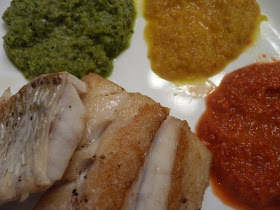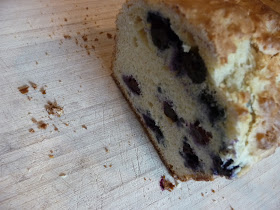Those who know me know that my favorite cut of beef is the standing rib roast. I eat rib-eyes, strip steaks, sirloin steaks, flank steaks, and porterhouses. I even eat tongue and tripe. But, the one cut of beef that always gets my attention is the rib roast, which is what is commonly known as prime rib.
The rib roast is typically the meal for holidays in my family, such as at Christmas time. I've previously posted the
Bolek Family Standing Rib Roast, which I made last Christmas. As Easter approached, I wanted to make a rib roast again, but I wanted see if I could tweak the recipe a little.
I made two significant changes to this recipe. First, I decided to do an herb crust. I still used the french onion soup mix, but I added a lot of fresh herbs (rosemary, sage and thyme), and used Dijon mustard to hold the mixture in place. The second major change is that I decided to have a Bordeaux Thyme Au Jus. Overall, the rib roast tasted a lot like the Bolek Family Standing Rib Roast, primarily due to the use of the French onion soup mix, but the au jus provided just enough of change to this dish.
HERB-CRUSTED RIB ROAST WITH BORDEAUX THYME AU JUS
A Chef Bolek Original
Serves 10-15
Ingredients (for the Rib Roast):
10 pounds of standing rib roast, with bones
4 packs of dried onion soup mix (such as Knorr's French Onion Soup mix)
2 tablespoons of fresh rosemary, minced finely
2 tablespoons of fresh sage, minced finely
2 tablespoons of fresh thyme, minced finely
1 tablespoon of garlic powder
1 tablespoon of black peppercorns
Ground pepper, to taste
1/4 cup of Dijon mustard
Ingredients (for the au jus):
2 cups of Bordeaux wine
2 tablespoons of finely chopped thyme
Salt, to taste
Ground pepper to taste.
Directions:
1. Sear the rib roast. Heat the oven to 500 degrees Fahrenheit. At this point, you want to sear the meat to lock in the juices for the long, dry heat of the cooking process. Place the rib roast in a roasting pan and place it in the oven for about fifteen minutes. When you pull out the roast, you want to see the roast stating to brown.
2. Prepare the rub. While the rib roast is searing in the oven, it is time to prepare the rub. Combine the packs of dried onion soup mix, rosemary, thyme and garlic, along with ground pepper and salt. Make sure that everything is mixed thoroughly.
3. Apply the rub. Remove the roast from the oven and place on top of the oven. Begin by applying a thin layer of mustard to the top and sides of the roast. Take small handfuls of the rub and begin to rub the all of the meat. Be careful when doing this because both the rib and the roasting pan will be very hot. Use all of the rub and try to get the rub on all sides.
4. Continue to cook the roast. Lower the temperature of the oven to 325 degrees Fahrenheit. Return the rib roast to the oven, covered, to cook for about three hours. I usually try to cook it for about two and one-half hours initially, and then check the temperature. About once per hour, you should baste the roast with the juices; however, do not keep the roast open for long, as that will prolong the cooking.
5. Remove the roast and let it rest. When the roast has reached about 125 to 130 degrees, which between rare and medium rare, I pull the roast out and let it rest for about fifteen minutes. The roast will continue to cook and increase about ten degrees. (I like the rib roast to have a good pink center to it.) When it is done, pull out the meat and wrap it in foil to rest for about twenty minutes.
6. Prepare the au jus. As the meat is resting, make the au jus. Spoon about two or three tablespoons of the fat and drippings into a sauce pan. Add the wine, stir and bring to a boil. Boil until the wine is reduced somewhat. Add the beef stock and continue to boil, whisking or stirring as it continues to cook down. Whisk in the thyme as the au jus continues to boil. After about twenty minutes or so, the au jus is ready.
Overall, I think that this recipe worked out well. The meat was very flavorful, although the crust had not "hardened" as much as I would have liked. The au jus also worked well with the meat, adding a little moisture to parts that may have been cooked medium and adding some additional flavors to the meat. If I had to choose between this recipe and the Bolek Family Standing Rib Roast, I think I would choose the latter. What can I say, I value traditions, including culinary ones.
ENJOY!

































